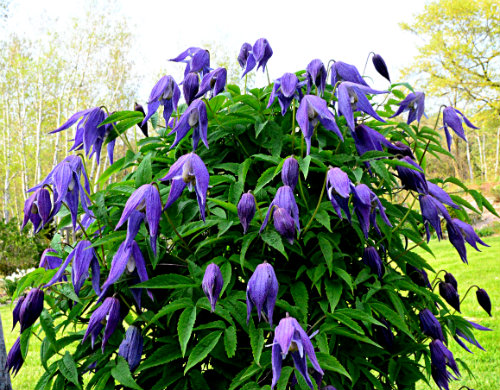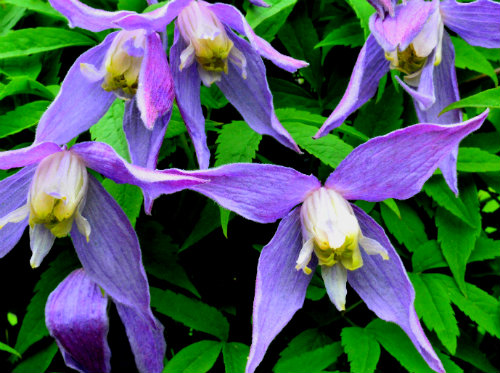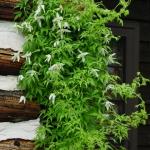
Clematis alpina
(Klem –uh-tiss AL-pine-a)
General Information:
Clematis alpina is a very hardy, early flowering vine that adds a great splash of color in your spring garden and then goes on to make interesting seed heads in late summer. As seen in the picture below, I grow it in a planter, in zone 5 and leave it outside all year. You can also plant it in the garden and just about forget about it. It doesn't need to be pruned, and it will not take over most trees and shrubs the way some larger clematis do.

Clematis alpina:photo by Robert Pavlis
Its main color is a blue/mauve but a variety called C. alpine var. sibirica (Siberian clematis) is white. If these colors are not to your liking cultivars of Clematis alpina are available in a variety of other colors including pinks and pale blues.
It is a Group 1 clematis so pruning should be done after it flowers in spring. If you want a taller plant, don’t prune it for a few years. After that, prune just for shape or size. In my planter I cut it to soil level after flowering so that it never gets taller than 3 to 4 feet.
C. alpina can be grown from seed fairly easily, but it does take some time. For more information on this see Growing Clematis From Seed.

Clematis alpina:photo by Robert Pavlis
This clematis is not prone to clematis wilt, but it is still a good idea to plant it a few inches lower than in the original pot.
Alpine clematis is a close relative of anemone and hepatica which have similar leaves and flowers. It belongs to the Atragene Group which also includes species such as C. chiisanensis, C. fauriei, C. koreana, C. macropetala, C. ochotensis, C. sibirica, C. turkestanica.

Clematis alpina:photo by Robert Pavlis
Life Cycle: woody vine
Height: 3 m (10 ft)
Bloom Time: spring
Natural Range: European Alps
Habitat: rocky and wooded sub-alpine areas
Synonyms: Atragene alpine
Cultivation:
Light: full sun to part shade, especially in warmer climates
Soil: well drained, humusy
Water: drought tolerant once established
USDA Hardiness Zone: 3 - 9
Propagation: seed, layering, softwood or semi-hardwood cuttings
Seedex availability (ORG&HPS annual Seed Exchange): usually

